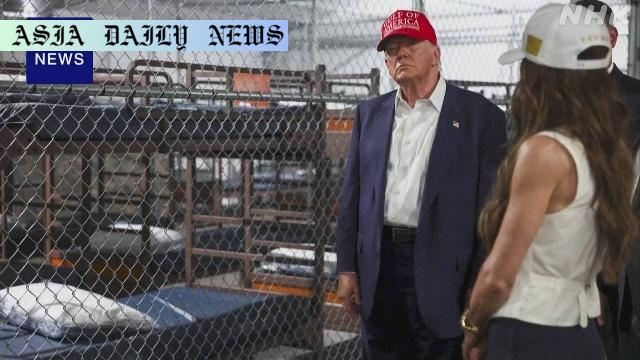Immigration: US President Donald Trump visits controversial migrant detention site known as ‘Alligator Alcatraz’ in Florida wetland.
Facilities built for housing 5,000 migrants located in Florida swamplands.
Dubbed ‘Alligator Alcatraz,’ the site is considered hazardous for escape attempts.
President Trump emphasized its purpose as a stronghold against illegal immigration.
Critics question ethical and safety concerns about the facility’s location.

President Trump Unveils Controversial Florida Detention Facility
President Donald Trump’s visit to the newly established immigration detention center in a Florida wetland has raised concerns and sparked conversation across the political spectrum. The facility, colloquially called ‘Alligator Alcatraz,’ is unique, not only because of its location but also for the dangerous natural barrier it presents to those wishing to escape. With the capacity to house 5,000 migrants, the center is designed to hold detainees who have been apprehended crossing the U.S.-Mexico border illegally.
Trump toured the site on Tuesday, describing it as both strategically situated and nearly impossible to escape. ‘I looked outside, and that’s not a place I want to go hiking anytime soon,’ the President remarked. He further added that ‘the only way out is really deportation,’ signaling his administration’s firm stance on immigration policy.
Why ‘Alligator Alcatraz’?
Situated in Florida’s wetlands and surrounded by a population of native alligators, the detention center draws comparisons to the infamous Alcatraz prison in California, which held some of the world’s most notorious criminals until its closure in 1963. Critics have expressed dismay, arguing that the facility may pose both psychological and physical risks for detainees, given its isolation and perilous surroundings. While Trump emphasized the benefits of using such remote locations as deterrents for illegal immigration, human rights advocates voiced concern over the ethics behind such a decision.
Capacity and Future Plans
According to Reuters, ‘Alligator Alcatraz’ can hold up to 5,000 individuals, with detainees expected to begin arriving as early as Wednesday. Originally conceived as part of President Trump’s proposal to expand detention facilities for migrants, the center reflects his earlier directive in May to rebuild and revamp a highly secure facility akin to Alcatraz. The location, while strategically deterrent, may also face logistical challenges due to its remote nature with limited transportation connections, being stationed near an airport.
Some experts predict that further facilities of similar design might be built in other parts of the U.S. in response to climbing immigration figures. However, others warn about neglecting humanitarian considerations, urging the current administration to strike a balance between security and dignity.
Reactions from the Public and Officials
The reaction to Trump’s visit and announcement has been swift and polarized. Supporters of tougher immigration policies have lauded the administration for taking measures to strengthen borders and provide a stark warning to potential offenders. Many believe facilities like ‘Alligator Alcatraz’ serve as powerful statements about the U.S.’s commitment to law and order.
Conversely, critics have pointed to additional moral dilemmas posed by locating human facilities in hazardous environments, including its implications on detainees’ wellbeing. Activists insist that a step this drastic indicates a prioritization of optics over humane treatment, igniting further debates on the ethics of the immigration policy being enforced in the U.S.
What remains clear is that the facility’s unveiling has pushed immigration enforcement strategies into the spotlight once again. As detainees begin arriving, the debate over whether environments like ‘Alligator Alcatraz’ are necessary security measures or unethical actions in handling migrant populations is likely to persist.
Commentary
Balancing Security and Human Rights for Migrants
The establishment of ‘Alligator Alcatraz’ introduces yet another complex chapter in the saga of U.S. immigration policy. President Trump’s decision to build this facility in a seemingly inhospitable Florida wetland underscores his administration’s commitment to creating strong deterrent measures against illegal immigration. However, this step raises significant ethical questions that require careful consideration.
Ethics Versus Security in Immigration Tactics
On one hand, security proponents may argue that the remote and hazardous placement of the detention center symbolizes the lengths to which the United States is willing to go to enforce its laws. Such installations may be effective in deterring individuals who risk crossing borders illegally. Yet, the isolated positioning within a literal swamp not only exposes detainees to the threat of dangerous wildlife but also highlights how far the debate between ethics and security has shifted.
A Need for Humane Solutions
It is imperative to remember that while border security is crucial, humane treatment of individuals seeking refuge is equally non-negotiable. The decision to build ‘Alligator Alcatraz’ sets a precedent that must now be evaluated closely by legal experts, human rights organizations, and policymakers to ensure that families and individuals retained at such facilities are not stripped of their dignity.
Overall, while bold decisions are often necessary to uphold law enforcement, they should never come at the cost of compromising basic human rights and values. The United States has an opportunity to prove that strength and compassion can coexist in policy implementation. Hopefully, this controversial decision leads to a broader conversation on finding a balanced and ethically sound approach to immigration challenges.


